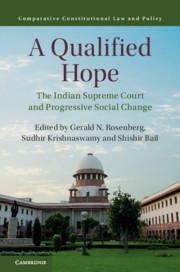Book contents
- A Qualified Hope
- Comparative Constitutional Law and Policy
- A Qualified Hope
- Copyright page
- Contents
- Notes on Contributors
- Foreword
- Acknowledgments
- Introduction
- Part I The Supreme Court of India – An Institutional Overview
- Part II The Supreme Court of India, Social and Political Mobilization
- Part III Welfare Rights and the Environment
- 9 A Case for Qualified Hope?
- 10 Implementation in the Delhi Pollution Case
- Part IV Discrimination
- Conclusion
- References
9 - A Case for Qualified Hope?
The Supreme Court of India and the Midday Meal Decision
from Part III - Welfare Rights and the Environment
Published online by Cambridge University Press: 19 August 2019
- A Qualified Hope
- Comparative Constitutional Law and Policy
- A Qualified Hope
- Copyright page
- Contents
- Notes on Contributors
- Foreword
- Acknowledgments
- Introduction
- Part I The Supreme Court of India – An Institutional Overview
- Part II The Supreme Court of India, Social and Political Mobilization
- Part III Welfare Rights and the Environment
- 9 A Case for Qualified Hope?
- 10 Implementation in the Delhi Pollution Case
- Part IV Discrimination
- Conclusion
- References
Summary
This chapter critically evaluates the impact of the Indian Supreme Court's interim orders in the Right to Food case, a Writ Petition seeking better implementation of the Midday Meal Program (the largest school nutritional program in the world). We cite significant and varied empirical and social science evidence demonstrating that the Program expanded significantly – from a quantitative as well as a qualitative standpoint – in the years immediately following the Court's orders. The harder question is whether the expansion in the Program was "caused" by the Court's intervention, or was largely the consequence of changed political circumstances. We argue that while the supportive political environment was undoubtedly a significant factor, the evidence available seems to indicate that the Court played an important role too. These orders helped in improving the scheme in certain specific respects, in bringing sustained media attention to the issue, in entrenching the Program against subsequent shifts in political priorities, and in providing a platform for the broader social movement to coalesce around. The experience suggests that there is room for "qualified hope" as to the ability of courts to help realize socio-economic rights, albeit in certain limited situations and in partnership with other actors.
Keywords
- Type
- Chapter
- Information
- A Qualified HopeThe Indian Supreme Court and Progressive Social Change, pp. 243 - 268Publisher: Cambridge University PressPrint publication year: 2019

